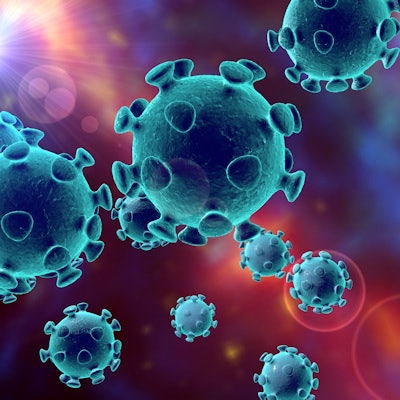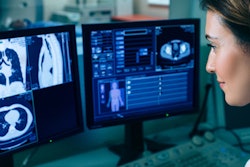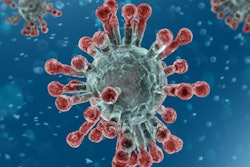
An artificial intelligence (AI) algorithm developed to help diagnose pneumonia on chest x-rays could also be useful for detecting and monitoring COVID-19, potentially enabling early isolation and administration of supportive therapies, according to research published online on March 20 in the Journal of Thoracic Imaging.
In a research letter, first author Dr. Brian Hurt and colleagues from the University of California, San Diego (UCSD) shared results from applying their pneumonia AI algorithm to chest x-rays from a small sample of COVID-19 patients. They found that their algorithm, which augments radiographs by overlaying a probability map for pneumonia, yielded accurate results for pneumonia in all of the COVID-19 cases.
"Although further study is required to evaluate the effectiveness of this algorithm across multiple institutions, these results provide further evidence that this approach could be a powerful tool for physicians and other healthcare providers to provide more reliable early diagnosis of infection," they wrote.
Approximately 75% of patients hospitalized with COVID-19 develop viral pneumonia, and 17% progress to the often-fatal acute respiratory distress syndrome (ARDS). Chest radiographs are often obtained to triage and perform follow-up in patients with suspected pneumonia -- including patients with the novel coronavirus. As a result, the UCSD team of researchers sought to determine if its pneumonia AI algorithm could also be useful in the context of COVID-19.
The team applied the algorithm to 10 frontal chest x-rays from five patients who were treated in the U.S. and China, and whose exams were published in five recently published COVID-19 epidemiological studies and case studies.
In a set of serial chest radiographs of a patient from the U.S., the algorithm accurately predicted and consistently localized areas of pneumonia with increasing likelihood as the subtle airspace opacities increased over time, according to the authors.
"It is worth noting that each radiograph was analyzed by the algorithm independently without awareness of the time course or relationship of previous films," they wrote.
The algorithm's predicted probability map also correctly localized the findings and assigned likelihoods that mirrored the severity of the imaging findings in the radiographs of the four patients from China, according to the researchers.
"These results illustrate a surprising degree of generalizability and robustness of the [deep-learning] approach that we recently proposed, suggesting that it may have utility in early diagnosis and longitudinal follow-up of suspected pneumonia, including patients with COVID-19 pneumonia," they wrote.
The research provides a tangible example of how physicians and radiologists can work with AI, according to the authors.
"This has the potential to augment the diagnostic abilities of physicians at the point of care, highlighting subtle abnormalities that may be missed by less experienced physicians, and triage patients for computed tomography," they wrote. "It may also help physicians track the daily evolution of the pulmonary manifestations over a patient's hospitalization before development of diffuse alveolar damage or acute respiratory distress syndrome. As viral epidemics such as COVID-19 place a greater strain on the health care system, it may also provide a mechanism of workload relief and earlier advanced interpretation."




















